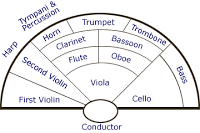

| Online: | |
| Visits: | |
| Stories: |

| Story Views | |
| Now: | |
| Last Hour: | |
| Last 24 Hours: | |
| Total: | |
The market of student orchestras
Read aguanomics http://www.aguanomics.com/ for the world’s best analysis of the politics and economics of water  Simon writes*
Simon writes*
Whenever someone goes to a concert by a student orchestra, they’re usually struck by the enthusiasm of the young amateur players, all enjoying the opportunity to make great music together. Yet underlying this seemingly innocent enthusiasm is a fierce competition between orchestras, as they all try to outdo each other to get the most (and most talented) players.
One might wonder why I would describe the situation as a competition. Surely, making music is a friendly and convivial exercise enjoyed by all together? While that sentiment might ideally be true, the reality is simply that an orchestra needs quite a lot of members to perform the pieces they want to perform. The great works of the late Romantic repertoire, for example, all require triple woodwinds or more (meaning three or more each of flutes, oboes, clarinets and bassoons), and lots of string players to balance this woodwind onslaught. Whenever an orchestra plays such a piece, it ideally wants to get all required players as members; the alternative is hiring them, which is doubly expensive (the hired people do not pay membership fee and often ask for paid compensation). Moreover, the quality and atmosphere of the orchestra vastly improves if the orchestra is well-filled and balanced. And for those reasons, the student orchestras engage in a competition to lure members towards them in a competitive market.

How can we characterize this market? At first glance, it might seem that the market is not national at all, but rather consists of several fractured, regional markets. The student orchestras in Amsterdam, in that view, would only compete in the ‘Amsterdam market’. The different orchestras in that regional market would perform the role of oligopolists, each holding a large part of the market share. This view is to a certain extent correct, but also simplistic. Most members of orchestras are indeed from the city the orchestra is based in; however, a significant minority of the best orchestras is filled with students from other cities. Those orchestras have managed to capture a part of their competitors’ natural market. How have they managed to do so? Clearly, the benefits they offer to those members outweighs the transaction costs they incur (long travel time, less engagement with other orchestra members because you live further away, et cetera).
Several reasons come to mind. First, it is clear that these orchestras are dominant parties in the markets in terms of size and (perceived) quality. Related to this is a strong brand recognition and positive reputation. Even if smaller orchestras might be as good as those bigger orchestras, their relative anonymity and worse reputation prevents some from becoming members. The final reason is very interesting: major student orchestras have a lot of members from the ‘premier’ youth orchestras, which attracts people from those youth orchestras to them. In economic terms, we could think of this as firms successfully cornering early parts of the supply chain, thus diverting more goods (orchestra members) towards them.
Bottom Line Student orchestras engage in competition in what could be described as a market. Though this market is to an extent fractured in regional markets, the competition for the best talent is national.
* Please comment on these posts from my microeconomics students, to help them with unclear analysis, other perspectives, data sources, etc.
Source: http://www.aguanomics.com/2016/02/the-market-of-student-orchestras.html


